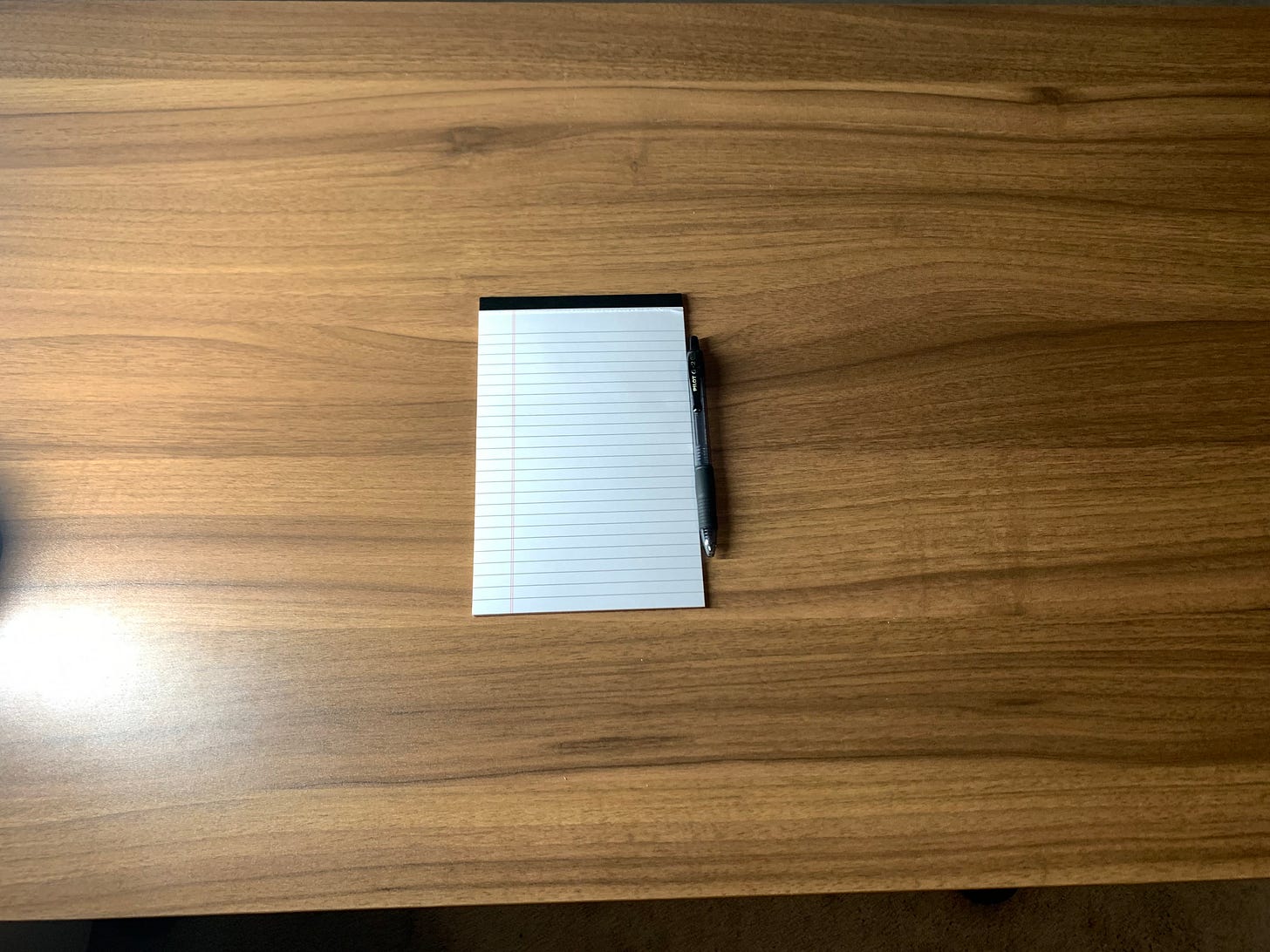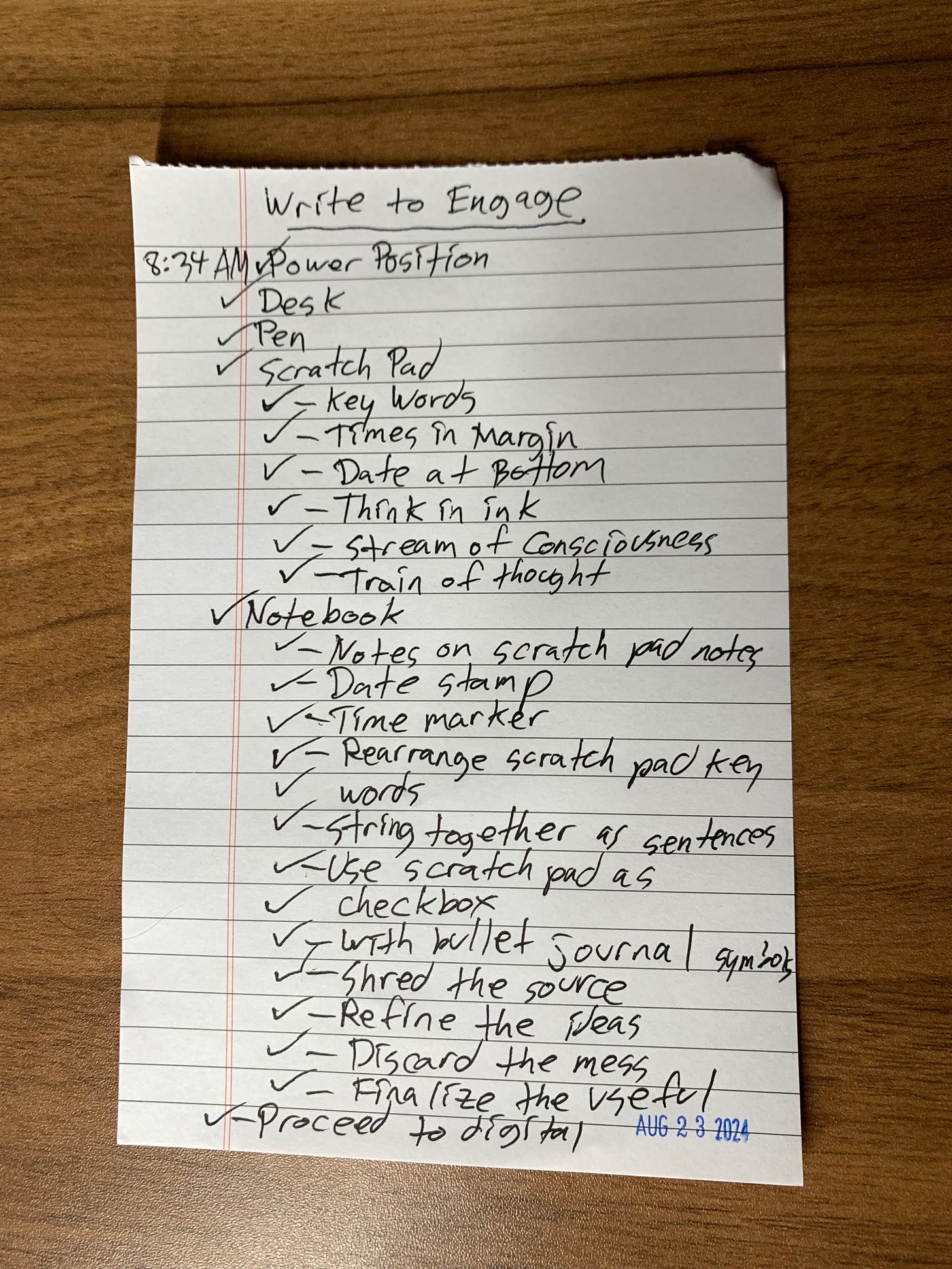Wield the Power of Words
How to use writing to get smart and creative

Whenever I am in a workflow funk, writing has proven to be a reliable recourse for unlocking my intelligence and unblocking my creativity. Words have power. Naming your thoughts make them wieldable. And wielding your thoughts is how you master your universe.
Here is a method I developed this morning for turning my thoughts into words and my words into things of value.
Step 1: Get thee to a writing surface
First you need to get into a functional and comfortable position for focused writing. Get to your desk or any surface that is flat, sturdy, spacious, and clear. Your writing space should also be in an environment that is conducive to concentration. You should be in a place that is well-lit and non-distracting: i.e., quiet and still. Such a spot is a place of power.
One incidental advantage of the habit of writing out one’s ideas is that it promotes concentration as almost no other practice does. As one who has written daily newspaper editorials or weekly magazine columns for many years, I can testify that nothing forces one to pull one’s thoughts together more than deciding on a topic, sitting before the typewriter, feeding in a clean sheet of paper, and then trying to frame one’s exact theme, title, and opening paragraph.
Francis Bacon summed it up with unsurpassable conciseness: “Reading maketh a full man, conference a ready man, and writing an exact man.”
— Henry Hazlitt
Step 2: Express your thoughts as words
Place a notepad on that writing surface directly in front of you. Otherwise the surface should be completely clear. For maximum engagement, singularly focus on as few things as possible.
Put pen to paper and take notes on your thoughts about a single subject. One way of starting is to write the first word that comes to mind. Give that word its own line to leave space for adding further notes later. See what other word or expression doing that makes you think of and write that down on the second line. Repeat this process until you have something on every line of your notepad sheet.
As you proceed, try to home in on a theme. As soon as you can, title your sheet based on that theme. A title can help you keep your train of thought from getting sidetracked. When you have something on every line of your sheet, tear it off and place it to the side where it is still visible.
In my experience, “key word” note-taking in this manner generates the verbiage I need to write linearly and coherently. If the same proves true for you, proceed with the following.
Step 3: Assemble your words in sentences
Place a notebook in front of you and journal. Take the ideas you just developed using key words and express them more fully in the form of complete sentences. Do this until you’ve captured the essence of your ideas. Then slide your notebook off to the side in front of your notepad sheet.
In my experience, complete-sentence journaling in this manner matures my thinking to the point where I am ready to extract long-term value from the ideas expressed. If the same proves true for you, proceed with following.
Step 4: Edit and rewrite your sentences
Place a laptop computer in front of you. Or sit down at your desktop computer with your notebook and notepad sheet. In a word processor (Notion is my app of choice), rewrite your journal entry. Refine your wording. Add elaborations. Insert points you missed.
Return to your journal entry and use it as a checklist. Go through it line-by-line. Verify whether you’ve incorporated into your digital write-up everything of value from each line and then make a checkmark next to that line. Then do the same thing with your key word notes sheet. Whenever you notice something you missed, work it into your digital write-up.
This is how you can develop any written asset: a memo, a project plan, a how-to guide, etc.
Step 5 (Bonus): Revise for public consumption and publish
Now that you have created something of value for your own life, consider sharing it more broadly to benefit others, too! Further edit, revise, and rewrite your copy for publication. Publish it as an article or a scripted video in whatever venues you have access to: Substack, YouTube, a podcast, etc. Not only will this benefit others, but it will further benefit yourself. Pushing yourself to make your ideas clear for others will help you understand them better, too.
When we write out our ideas, we are at the same time testing, developing, arranging, crystallizing, and completing them. We imagine ourselves not only making these ideas clear to others, but making them seem as important to others as they do to ourselves. So we try to make what was vague in our minds precise and definite; what was implicit, explicit; what was disconnected, unified; what was fragmentary, whole. We frame a generalization, then try to make it as plausible as we can; we try to think of concrete illustrations of it. And as we do this, we also expose it to ourselves—and sometimes, alas, find that it is empty, untenable, or sheer nonsense.
— Henry Hazlitt
Once you’ve completed step 4, creating something publishable can be surprisingly easy. Indeed, I myself just went through the above five steps to create this very essay about those steps. (See the appendix below where I show my work.)
I have found the above method to be a powerful way to “think in ink” and put my notions in motion. I hope you do, too. To unlock your intelligence and unblock your creativity, tap the power of words by following this five-step drill:
Get situated for concentrated writing.
Use key-word notetaking as an easy on-ramp into the world of words.
Use complete-sentence journaling to develop your ideas.
Use digital word processing to refine your ideas.
Publish your ideas to further refine them and to be of service to others.
Appendix
Here are photos of my process in following the above steps to develop this essay about those steps.
Step 1: My writing surface
Step 2: My key-word notes
Step 3: My complete-sentence journal entry
Step 4: My personal “how-to” guide write-up for this process
Step 5: My essay manuscript






